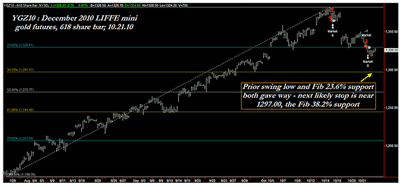The recent strong run up in the gold futures market has finally begun to reverse, offering a near-textbook-quality breakdown below a key Fibonacci retracement level; one that typically warns of further declines to follow.
It's not foolproof, but you'd be surprised how often a break below the Fibonacci 23.6% retracement level (particularly after a massive run higher in a stock or futures contract) will give advance warning of a fast continuation move down to the next Fibonacci support—the 38.2% retracement of the previous trend move.
Gold futures (December 2010 LIFFE mini-gold, ticker YGZ10) are shown in the chart above. These ran from 1159.60 all the way to 1382.20 in less than three months, helping fatten the margin accounts of long gold bugs along the way. The recent reversal gave some advance warning (the October seasonal chart, Commitment of Traders reports, cyclical indicators, and so forth), although there were other powerful hints that the move may still have had enough steam to hit 1450 or even 1500 (a breakout of a key Keltner resistance level, for example). Regardless, gold decided to take a breather just shy of 1400, perhaps waiting for a more opportune time to make a move to higher price levels.
Now, of course, some of the "buy on dips" crowd may have thought the decline to 1326 was a new buying opportunity, failing to realize that if the Fibonacci 23.6% retracement level (1329.61) was taken out, there was a high probability that gold would continue to descend toward the next key Fibonacci retracement (38.2%) at 1297. With price having already closed decisively below the Fibonacci 23.6% level, one way to play this move is to short gold futures near 1327-1329, placing a buy-to-cover order near 1332 and then holding the short position on an anticipated move down to the Fibonacci 38.2% support at 1297. Assuming an entry at 1329, a stop at 1334, and a conservative price target of 1300, you end up with a very favorable risk:reward ratio of about 5.8:1.
If this is a true trend reversal, the probabilities are excellent that gold will reach 1300 much sooner than it will hit a stop loss at 1334, especially if latecomers to the gold party begin to panic and start offloading newly acquired long gold positions with as much fervor as they originally acquired them.
In case you're wondering, the silver futures market is also close to a break below its own Fibonacci 23.6% retracement level (based on YIZ10, the December 2010 LIFFE mini-silver contract); if you see a daily close below 22.88, then silver may also be expected to take a trip down to its own 38.2% Fibonacci support at 21.84. In this case, you might consider a short entry near 22.80, a stop loss near 23.05, and a conservative target of 22.00, all yielding a very attractive risk:reward ratio of 3.2:1.
If you only remember one thing from this article, this should be it: After an extended trend move (up or down) in a commodity or stock, check to see if the 23.6% Fibonacci retracement level holds. Particularly in the case of a formerly up-trending market, a significant break of the Fibonacci 23.6% support level is a likely indication of more bearish intentions by the market in question, and the Fibonacci 38.2% support level is usually realized quickly once the break occurs.
Watch for Fibonacci 23.6% breaks after gargantuan up- or down-trending moves; you may be amazed at how the use of this simple tactic can help you identify meaningful trend reversals and the trading opportunities that come in their wake.
By Don Pendergast of ChartW59.com





















